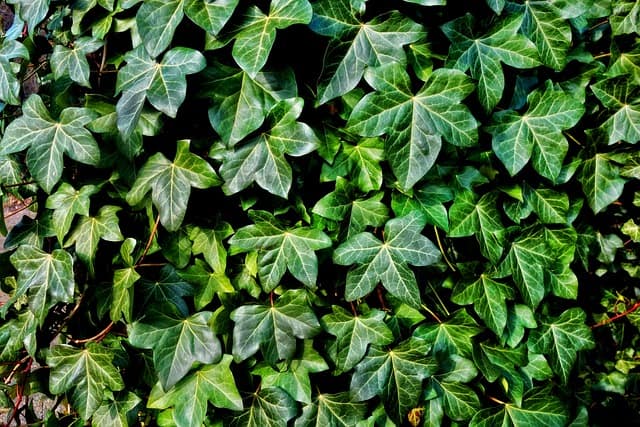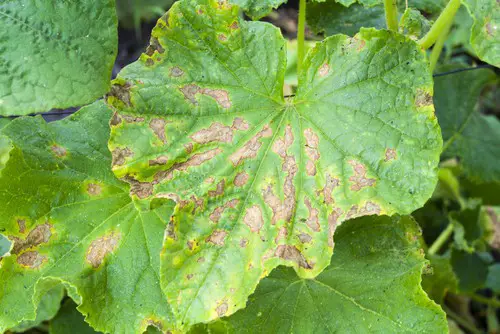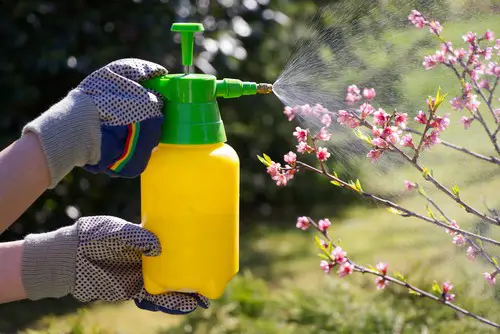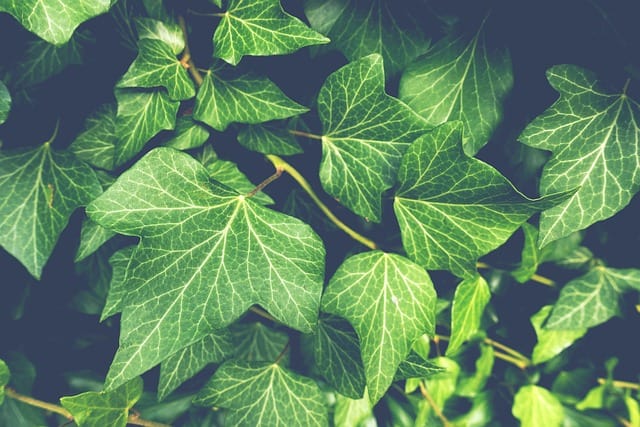Ivy is a popular houseplant known for its lush green foliage and low maintenance. However, brown spots on ivy leaves can be a common issue that many plant owners face. These spots can be unsightly and may indicate an underlying problem that needs to be addressed.
Understanding the causes and symptoms of brown spots on ivy leaves is crucial in treating and preventing them. Brown spots on ivy leaves can be caused by fungal or bacterial infections, overwatering, inadequate lighting, or pests.
Symptoms may vary depending on the type of infection or issue, but they typically appear as brown or black spots on the leaves, which may spread and eventually cause the leaves to wither and die.
Proper treatment and prevention methods can help address brown spots on ivy leaves. This may include pruning affected leaves, adjusting watering and lighting conditions, using fungicides or pesticides, and improving air circulation.
Taking the necessary steps to prevent brown spots from forming can help keep ivy plants healthy and thriving.
Key Takeaways
- Brown spots on ivy leaves can be caused by various factors, including fungal or bacterial infections, overwatering, inadequate lighting, or pests.
- Symptoms of brown spots on ivy leaves include brown or black spots on the leaves, which may spread and cause the leaves to wither and die.
- Proper treatment and prevention methods, such as pruning affected leaves, adjusting watering and lighting conditions, and using fungicides or pesticides, can help address brown spots on ivy leaves and keep plants healthy.
Also read:
Understanding Brown Spots on Ivy Leaves

Brown spots on ivy leaves are a common issue that gardeners face. These spots can be caused by various factors, including fungal and bacterial infections, pests, environmental stress, or poor plant care.
The most common cause of brown spots on ivy leaves is fungal infections. Fungi such as Cercospora, Colletotrichum, and Gloeosporium can cause large tan to brown spots on the leaves, which may have black specks or fungal fruiting bodies visible in the dead tissue.
These spots can also appear speckled, and the fungus may infect the stems, leading to tip dieback. Copper fungicides are recommended for the treatment and prevention of ivy leaf spots caused by fungi.
Bacterial infections can also cause brown spots on ivy leaves. The bacteria may enter the plant through natural openings or wounds, causing light green, water-soaked spots on older leaves that later turn dark brown to black and circular to irregular in shape.
The bacteria can potentially move into the stems, causing them to shrivel and darken, leading to branch dieback.
Environmental stress factors such as overwatering, underwatering, low humidity, or extreme temperatures can also cause brown spots on ivy leaves. Pests such as spider mites, mealybugs, and scale insects can also cause brown spots by sucking the sap from the leaves, leading to discoloration and necrosis.
To treat brown spots on ivy leaves, it is important to first identify the underlying cause. If the cause is a fungal or bacterial infection, applying fungicides or bactericides can help control the issue.
If the cause is environmental stress, adjusting the plant’s care routine can help prevent further damage. For example, providing adequate water and humidity levels, avoiding extreme temperatures, and ensuring proper drainage can help keep the plant healthy.
Symptoms of Brown Spots
Brown spots on ivy leaves are a common problem faced by gardeners. The symptoms of brown spots depend on the cause of the problem.
In general, brown spots can appear as circular or angular lesions on the leaves, and they may have a speckled appearance. The spots can be black, tan, or light green in color, and they may have a red margin.
Bacterial leaf spot is a common cause of brown spots on ivy leaves. The spots often start as light green, water-soaked lesions that later turn brown or black and often have a reddish margin. When veins become infected, the whole leaf may wilt. In severe cases, the entire leaf may turn brown and fall off.
Fungal leaf spot is another cause of brown spots on ivy leaves. The spots are usually circular and brown, and they may have a tan center. The spots may also have a speckled appearance and can be found on the entire leaf. In severe cases, the leaves may turn yellow and fall off.
Causes of Brown Spots on Ivy Leaves

Brown spots on ivy leaves can be caused by various factors, including fungal diseases, bacterial infections, and environmental stressors. Understanding the causes of brown spots on ivy leaves is essential for effective treatment and prevention of the issue.
One of the most common causes of brown spots on ivy leaves is overwatering. When ivy plants are overwatered, they can develop root rot, which can cause brown spots on the leaves. On the other hand, under-watering can also cause brown spots on the leaves, as the soil may dry out, leading to stress on the plant.
Low humidity can also cause brown spots on ivy leaves. Ivy plants thrive in moist environments, and when the humidity is too low, the leaves can dry out and develop brown spots. On the other hand, wet conditions can also cause brown spots, as excess water can lead to fungal diseases that cause brown spots on the leaves.
Fungal diseases, such as fungal brown spots, can also cause brown spots on ivy leaves. These diseases are often caused by a fungus that thrives in moist environments and can be spread through infected leaves.
Bacterial infections, such as bacterial leaf spot and leaf blight disease, can also cause brown spots on ivy leaves. These infections can cause yellow-brown or black spots or blotches on the leaves.
Spider mites can also cause brown spots on ivy leaves. These pests feed on the plant’s sap, causing damage to the leaves and leading to brown spots. It is essential to identify the cause of brown spots on ivy leaves to effectively treat and prevent the issue.
Types of Ivy Affected
Ivy plants are beloved by many gardeners for their lush, green foliage and ability to climb walls and trellises. However, brown spots on ivy leaves can be a common problem for many types of ivy, including English ivy and Pothos ivy.
English ivy (Hedera helix) is a popular type of ivy that is known for its ability to climb walls and trellises. It is a hardy plant that can grow in a variety of conditions, but it is susceptible to brown spots on its leaves.
These spots can be caused by fungal or bacterial infections, as well as environmental factors such as overwatering or poor air circulation.
Pothos ivy (Epipremnum aureum), also known as golden pothos, is another type of ivy that is commonly grown as a houseplant. It is known for its trailing vines and variegated leaves, but it can also develop brown spots on its leaves.
These spots can be caused by a variety of factors, including overwatering, poor drainage, and fungal or bacterial infections.
The American Ivy Society recommends that gardeners carefully monitor their ivy plants for signs of brown spots on the leaves. They suggest that gardeners take steps to improve air circulation around the plants, avoid overwatering, and remove any infected leaves or stems to prevent the spread of infection.
Overall, brown spots on ivy leaves can be a frustrating problem for gardeners, but with proper care and attention, it is possible to keep these plants healthy and vibrant.
Treatment and Prevention of Brown Spots

When it comes to treating and preventing brown spots on ivy leaves, there are several methods that can be used. Here are some of the most effective ways to deal with this issue:
- Removing infected leaves and stems: One of the first steps in treating brown spots on ivy leaves is to remove any infected leaves and stems. This can help slow down the spread of the disease and prevent it from affecting other parts of the plant.
- Pruning: In addition to removing infected leaves, pruning can also be helpful in preventing brown spots from spreading. By cutting away any dead or diseased branches, you can improve the overall health of the plant and reduce the risk of further damage.
- Fertilizing: Fertilizer can be helpful in promoting new growth and strengthening the plant’s immune system. However, it’s important to be careful not to over-fertilize, as this can actually make the problem worse.
- Using fungicides: Copper fungicides are often recommended for treating brown spots on ivy leaves, as they can be effective against both fungal and bacterial infections. However, it’s important to test the soil and make sure that the pH is within the appropriate range before applying any fungicides.
- Improving drainage: Poor drainage can contribute to the development of brown spots on ivy leaves, so it’s important to ensure that the plant has adequate drainage. This can be achieved by adding drainage holes to the pot, using a saucer or pebble tray, or using a soaker hose.
- Mulching: Mulch can be helpful in preventing moisture from evaporating too quickly from the soil, which can help keep the plant’s roots healthy. However, it’s important to be careful not to over-mulch, as this can lead to waterlogging and other problems.
- Maintaining cleanliness and sanitation: Keeping the plant and its surroundings clean can help prevent the spread of disease and pests. This can be achieved by regularly cleaning the greenhouse, removing dead leaves, and avoiding overhead watering.
- Using clippers and rubbing alcohol: Clippers and rubbing alcohol can be used to remove any infected leaves or stems. This can help prevent the spread of disease and improve the overall health of the plant.
- Improving ventilation: Good ventilation can help prevent the buildup of moisture and reduce the risk of fungal and bacterial infections. This can be achieved by opening windows or using fans.
- Using liquid plant fertilizer: Liquid plant fertilizer can be used to provide the plant with the nutrients it needs to grow and thrive. However, it’s important to be careful not to over-fertilize, as this can lead to nutrient burn and other problems.
- Quarantining infected plants: If you have multiple plants and one of them is infected with brown spots, it’s important to quarantine the infected plant to prevent the spread of disease to other plants.
Impact on Home and Environment

Brown spots on ivy leaves can have a significant impact on both the home and the environment. Here are some of the potential impacts:
Home
- Aesthetic Damage: Ivy is often used for decorative purposes in homes, and brown spots on the leaves can be unsightly and detract from the overall appearance of the plant.
- Reduced Air Quality: Ivy plants are known to help purify the air, but if they are suffering from disease or pests, they may not be as effective at removing pollutants from the air.
- Spread of Disease: If the brown spots are caused by a disease, it is possible that the disease could spread to other plants in the home or garden.
Environment
- Native Ecosystems: Ivy is not native to many regions, and if it is allowed to spread unchecked, it can have a negative impact on native ecosystems by crowding out native plants and altering the natural balance of the ecosystem.
- Winter Survival: If the ivy is suffering from disease or pests, it may be more vulnerable to the cold temperatures of winter, which could lead to the death of the plant.
- Climate Change: Ivy is a hardy plant that is able to thrive in a wide range of conditions, but if it is weakened by disease or pests, it may be less able to adapt to changing climate conditions.
- Trees and Shrubs: Ivy can climb trees and shrubs, which can cause damage to the bark and make the plants more vulnerable to disease and pests.
- Pets and Children: Some species of ivy are poisonous and can cause harm to pets and children if ingested.
It is important to take steps to address brown spots on ivy leaves to minimize their impact on the home and environment. This may include pruning affected leaves, treating the plant with fungicides or pesticides, or removing the plant altogether if it is beyond repair.
Frequently Asked Questions
How do you treat brown spots on ivy leaves?
Treating brown spots on ivy leaves involves identifying the cause of the problem. If the spots are caused by overwatering, the plant should be allowed to dry out before watering it again.
If the spots are caused by fungal infections, fungicides can be used to treat the plant. It is important to follow the instructions on the fungicide label and to apply it as directed.
Why does my ivy have brown spots on its leaves?
There are several reasons why ivy may have brown spots on its leaves. Overwatering can cause root rot, which can lead to brown spots on the leaves.
Fungal infections can also cause brown spots on the leaves. In addition, bacterial infections and insect infestations can cause brown spots on the leaves.
What does overwatered ivy look like?
Overwatered ivy can have brown spots on its leaves, but it can also have yellow leaves that are soft and mushy. The soil may also be wet and have a foul odor.
What are the dead spots on my ivy leaves?
Dead spots on ivy leaves can be caused by fungal infections, bacterial infections, or insect infestations. The spots may be brown or black and may have a yellow or red border.
How can you identify ivy diseases?
Ivy diseases can be identified by their symptoms. Fungal infections can cause brown spots on the leaves, while bacterial infections can cause yellow-brown or black spots or blotches on the leaves. Insect infestations can cause holes in the leaves or yellowing of the leaves.
What is the treatment for English ivy bacterial leaf spot?
The treatment for English ivy bacterial leaf spot involves removing infected leaves and stems and disposing of them properly. The plant should be treated with a copper fungicide, and the soil should be allowed to dry out between waterings.
It is important to follow the instructions on the fungicide label and to apply it as directed.

Hey, I’m Lisa and I’ve been an avid gardener for over 30 years. I love writing, talking and living in the garden! Feel free to connect with me on my socials below

